World War II Monument
Introduction
The National World War II Memorial, or the 'Second War Memorial', is located in the American capital, Washington D. C. , just in front of the National Mall, the open green space found in the centre of Washington D. C., which gathers together the most important monuments in the city - namely the Washington Monument and the Lincoln Memorial.
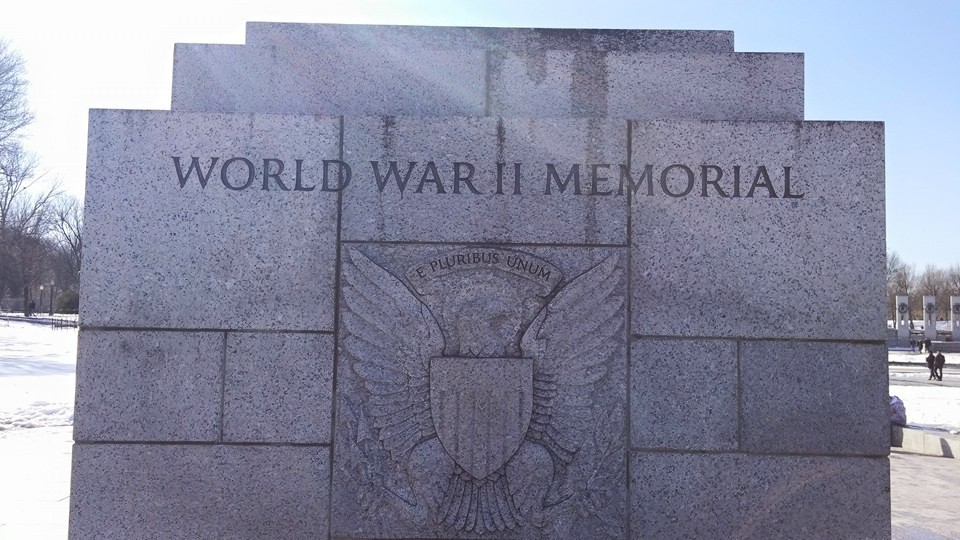
This monument, like its name indicates, is dedicated to all of the Americans who served in the Second World War. It was inaugurated in 2004, but its construction, particularly the decisions made about it were made very quickly, which caused a lot of controversy.
History
Although we all know about the Second World War, for those that don't, it's important to know that it was solely a European conflict to begin with, until Japan attacked the American fleet in Hawaii - this took place on 7 December 1941 in Pearl Harbour. (I have this information thanks to the fact that I am a huge fan of the film, Pearl Harbour, which revolves around this world-famous attack. )

Finally, the Allies won the war, and the dictatorial systems lost (Germany, Japan, and Italy), but all of the conflicting countries lost a lot from the war, from money to ruined cities, with the worst being the loss of 50 million lives (this is an approximate figure due to not all being accounted for). Amongst all of the victims that died during the war, it's approximated that some 400, 000 were American, and these formed part of the total 16 million who served for their country at some point during the Second World War.
The Monument
The monument itself is quite big, and is comprised of 56 granite pillars, each at a height of 6 metres, distributed in a semi-circle shape around the Memorial Plaza.
Each granite pillar is inscribed with the name of one of the 48 states that comprised the United States of America in 1945 (the year that the war ended): Massachusetts, Pennsylvania, Vermont, New Hampshire, New York, Rhode Island, Connecticut, New Mexico, Colorado, Arizona, Utah, Michigan, Illinois, North Carolina, South Carolina, Florida, Louisiana, North Dakota, South Dakota, Minnesota, Texas, Ohio, Virginia, West Virginia, Maryland, California, Washington, Delaware, Nevada, Montana, Alabama, Mississippi, Nebraska, Oklahoma, Kansas, Arkansas, Tennessee, Oregon, Idaho, Iowa, Wisconsin, Kentucky, Indiana, Missouri, Georgia, New Jersey, Maine, and Wyoming.
And, in addition to these, there is a granite pillar for each of the following places: District of Colombia (where Washington D. C. is found), the Alaskan territory, Hawaii, the Phillipines, Puerto Rico, Guam, American Samoa, and the United States Virgin Islands. Nowadays, there are 50 states: the 48 from when the war ended, plus Alaska and Hawaii.

And, on either side of these granite pillars, there are two triumphal arches opposite one another, which stand at a height of 13 metres tall. The first arch is inscribed with "Atlantic", and the second, "Pacific". Each tower has a lookout towards the centre of the plaza where many people take photos.
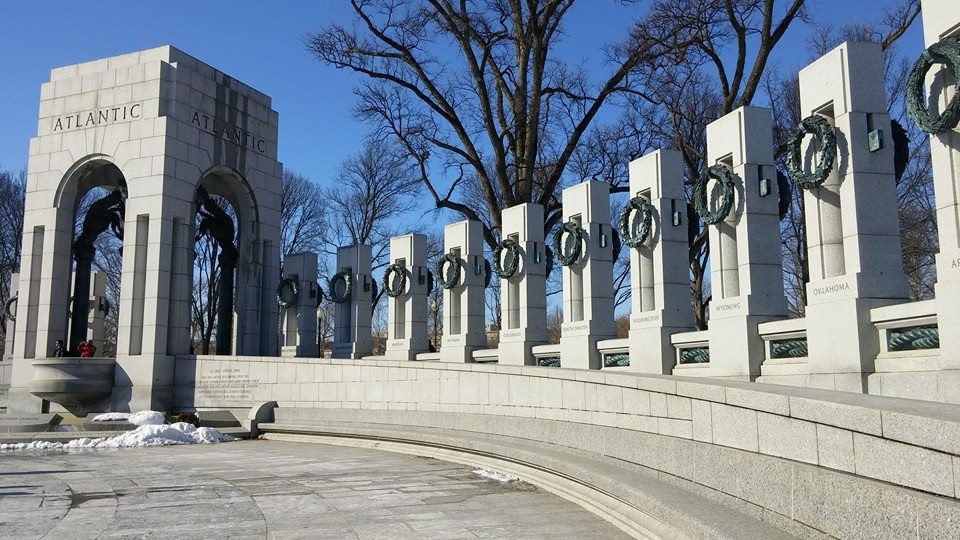
Actually, they are like two towers that have an arch on each side (four in total), and inside, they have two giant birds, and, on the floor, a plaque of the Second World War.

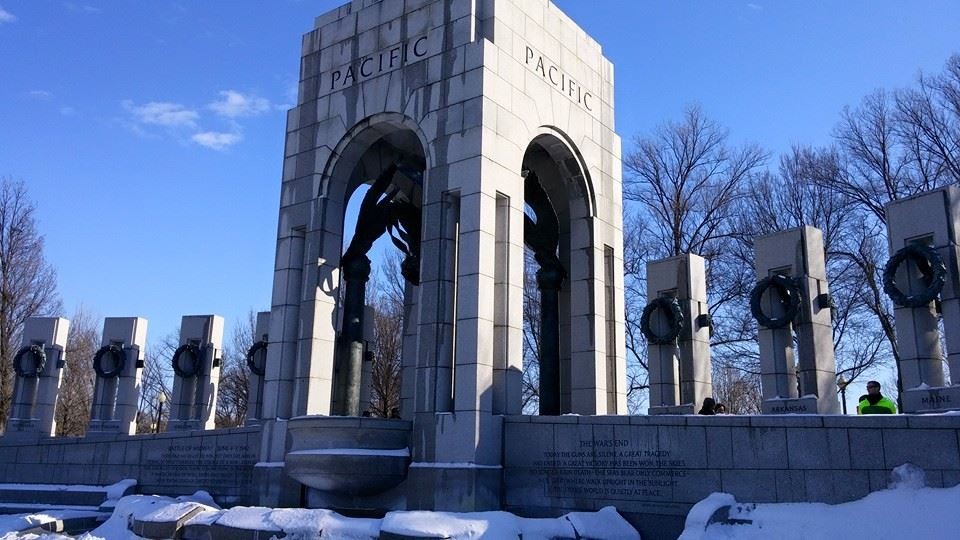
At the base of each of the arches, you will find inscriptions of all the important places/territories that took part in the war, depending on whether they were from the Atlantic or the Pacific. On the Atlantic side, I found the inscription for Alsace, which is where I did my Erasmus exchange (in Strasbourg).
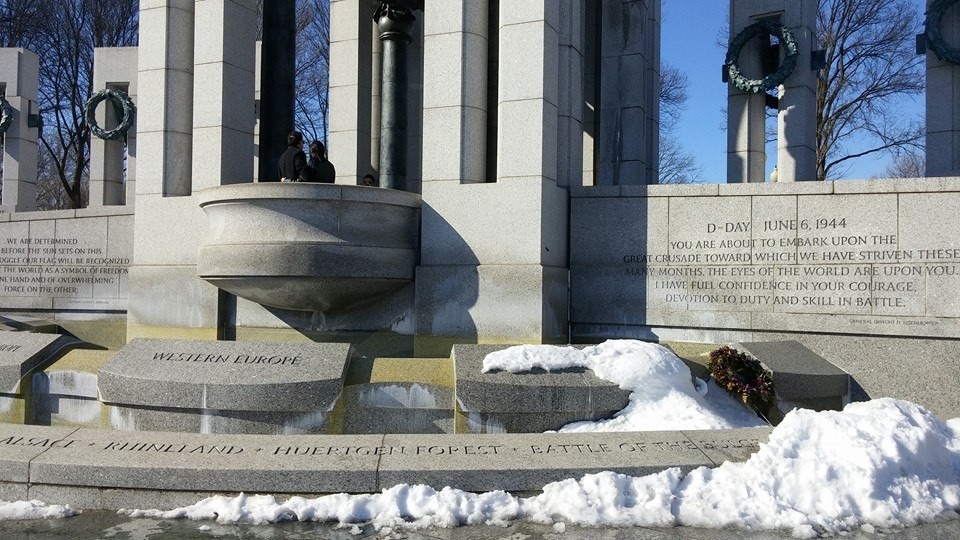
In the centre of the plaza, there is a pool which occupies the majority of it, with a fountain at each end, as well as jets of water. Although, when I went, it had just started snowing, so I couldn't see the pool very well...
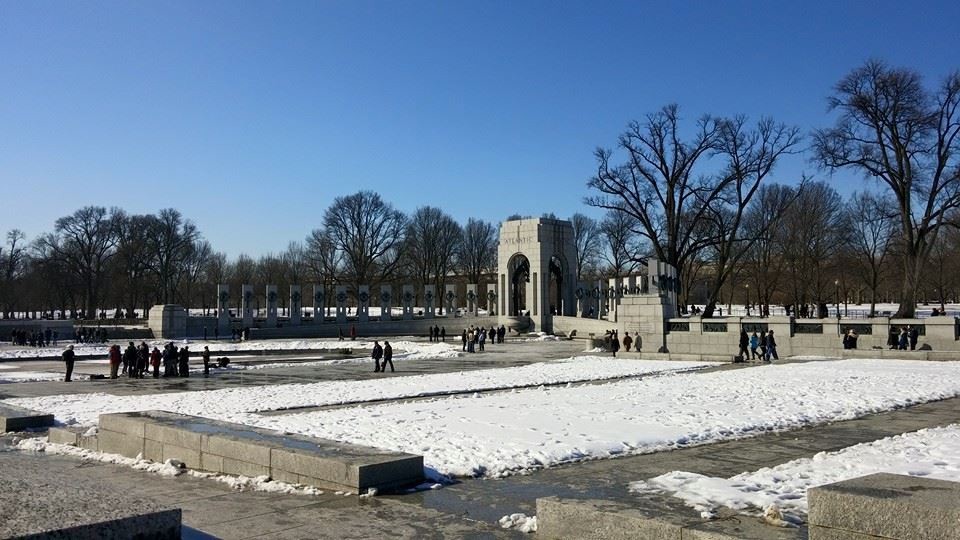
There is an American flag at each entrance to the monument, and, at the base, there is a shield with a coat of arms, the Marines, the Merchant Marines, and the Coast Guard. In addition to this, around the base, there is also the phrase "Americans came to liberate, not to conquer, to restore freedom and to end tyranny".
It's not only really common to see the flag of the United States at the sites of monuments, but also in many cases when you are walking through many American neigbourhoods.
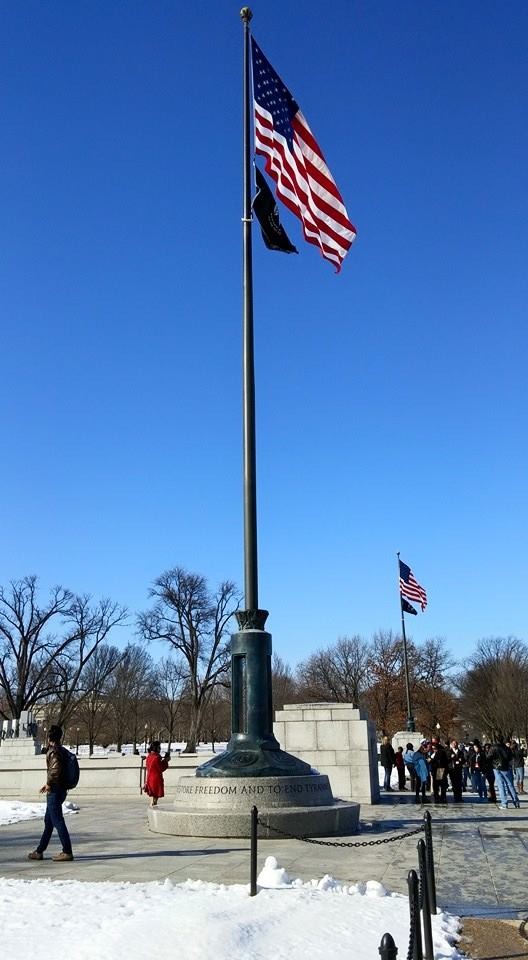
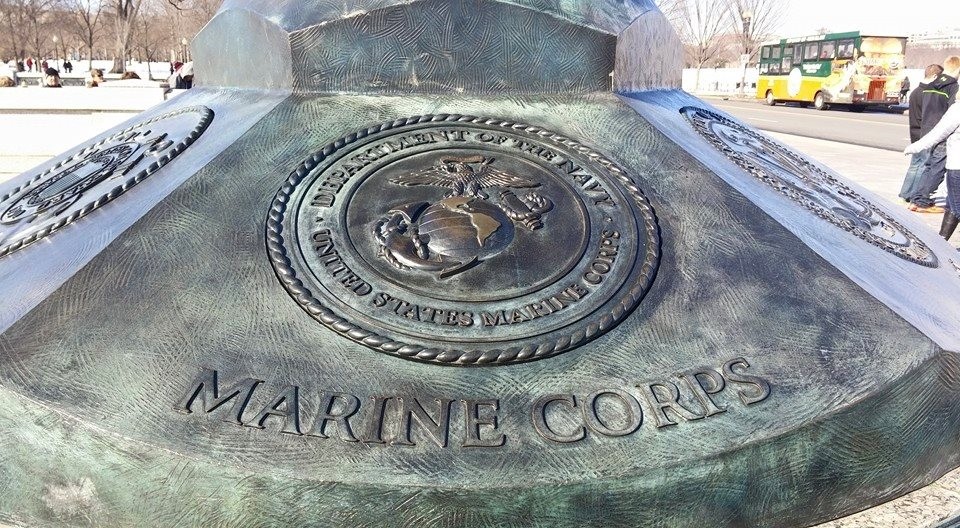
On the other hand, here you will also find the Freedom Wall, looking towards the Washington Monument and, just behind, you will find the reflecting pool and the Lincoln Memorial.
It's a mural that has 4, 048 stars, each of which represents 100 Americans who died during the Second World War. There is a plaque that has the title "The Price of Freedom", which explains the information that I was just giving you, and that the number of victims who perished during this war is only exceeded by the number of those from the American Civil War.
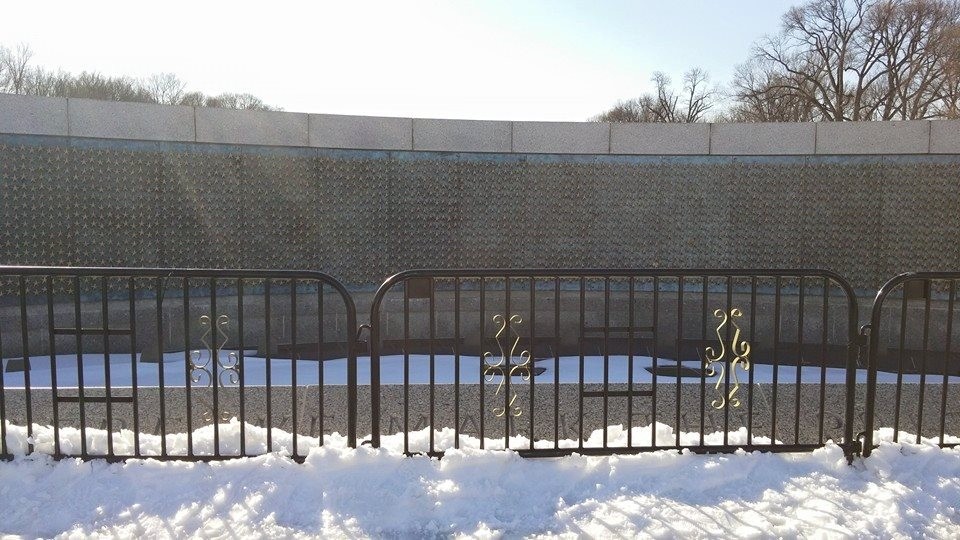

And, around the whole monument, there is a series of inscriptions, like the famous quote from President Franklin D. Roosevelt from the day after the attack on Pearl Harbour (which can be heard in the namesake film, or read in the attached photos), as well as quotes from General Eisenhower, President Truman, and Chester M. Nimitz, amongst others.

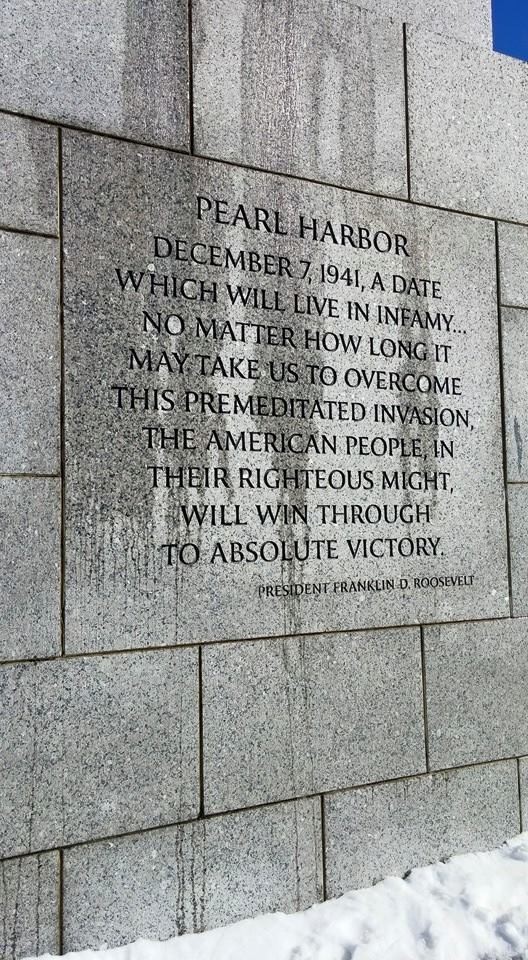
Opinion
Personally, it's one of my favourite monuments in Washington D. C. . I stumbled across it by chance during my first visit to the National Mall, and I like it as it is big, has great significance, and because it has all the US states written on it. The latter is important to me, as, since moving here, I have wanted to learn all the states off by heart, and what better way to remember them whilst I visit important monuments (they are also written on the Lincoln Memorial). In addition to this, thanks to certain films and documentaries that I have seen, I am very interested in learning about the Second World War, and Washington D. C. is arguably the best city to learn about this topic, thanks to all of the monuments and museums that contain information about it.
I really like the monument as a whole; each piece is essential for what it represents overall. The "Freedom Wall" is what I think gives it that final touch, not just because it has something more to it than the stone blocks, but because it's quite significant. With regards to the blocks for the states, the first one that you are going to look for, of course, is that of New York (well, at least that's what my friends and I did); and, the triumphal arches seem simply sensational to me.
Also, I could see bunches of flowers left anonymously by individuals and groups alike to honour the victims, which seems like a really nice gesture that people continue to remember the people who died over 60 years ago.
Obviously, as a suggestion to you all, I would say that you should visit during daylight, as, although I usually like seeing things illuminated by night, it's much better to see this particular monument before sunset, so that you can better appreciate the intricate detailing and read the inscriptions on the monument.

Prices, opening hours and additional information
The Monument is governed by the National Park Service, like the rest of the monuments found in the National Mall, and it is on the National Register of Historic Places.
On the monument's website, there is a list/registry where you can look for the names of the people who served during the Second World War, or even add a name retrospectively.
Visiting this monument is completely free. The fact that it's located outside means that there are no restrictions imposed upon its visitors, but, in reality, the majority of the museums and monuments in Washington D. C. are free to visit, which is really fortunate for those who are visiting the city. There's many a time where I think of Washington D. C. as a museum, and all of the pieces that it contains are priceless.
The opening hours of the National World War II Monument are 24 hours a day, 7 days a week. But, if you need to ask a question to a member of staff, they are only available from 9:30am to 11:30pm.

How to get there
If you are already at the National Mall, you can walk to the monument. You can also get there by metro, but you still have to walk a little bit; the stop is called "Foggy Bottom", and the lines that connect with it are the orange, blue, and silver. From there, you have to follow 23rd Street in direction of the Lincoln Memorial, and, once you have reached it, go towards Washington Monument, and half-way there, you will find this World War II Monument.
Photo gallery
Content available in other languages
- Español: Monumento de la Segunda Guerra Mundial
- Français: Mémorial de la Seconde Guerre Mondiale
- Italiano: Monumento della Seconda Guerra Mondiale
Rate and comment about this place!
Do you know National World War II Memorial? Share your opinion about this place.





































